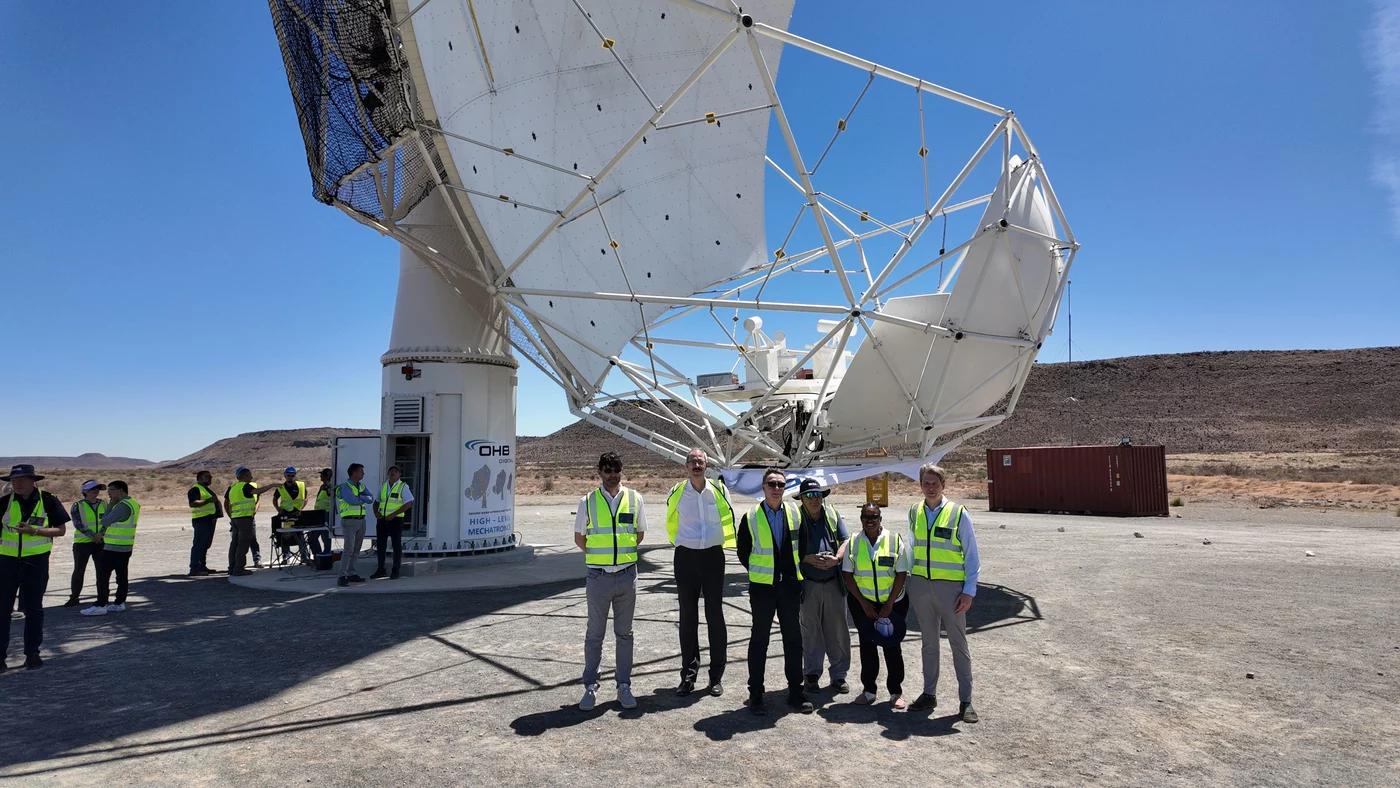
The world's largest radio telescope: listening to what moves the universe
OHB DIGITAL CONNECT HANDS OVER FIRST HIGH-PERFORMANCE ANTENNA FOR SKA PRECURSOR RADIO TELESCOPE IN THE KAROO SEMI-DESERT - UNIQUE COLLABORATION WITH THE MAX PLANCK INSTITUTE FOR RADIO ASTRONOMY CONTINUES
Karoo / Mainz / Bremen, February 21, 2024 . Among other things, it is designed to detect black holes, recognize rapidly rotating neutron stars and take a look back to a time when stars and galaxies were not yet born: The MeerKAT radio telescope with its 64 parabolic antennas in the South African Karoo semi-desert is now being extended by 14 new antennas. The special feature: The radio dishes are being gradually integrated into the "Square Kilometre Array" (SkA), an international project to build the world's largest radio telescope with sites in southern Africa and Australia. OHB Digital Connect GmbH, a subsidiary of the space and technology group OHB SE, handed over the first of the new high-performance parabolic antennas to the Max Planck Institute for Radio Astronomy and the South African operators today.
"It is fantastic to see that this first SKA antenna has been completed. This is an achievement of partners from science and industry, nationally and internationally. And I can't wait to see the first data from the antenna along with the rest of the array," said Prof. Dr. Michael Kramer, Director at the Max Planck Institute for Radio Astronomy in Bonn.
"The new antennas have been developed explicitly with a view to their integration into the SKA. Mastering this technical challenge and developing the design of the new antennas was only possible thanks to the close and trusting collaboration with the MPI for Radio Astronomy. We are starting today with a design that we have tested in a prototype, which is already delivering the first, very convincing scientific images. We now have our sights set on series production," says Fabrice Scheid, Managing Director of OHB Digital Connect's Mainz site.
The new high-performance antennas for the MeerKAT expansion have a diameter of approx. 15.5 meters and the antenna tower is 8 meters high. When assembled, the total height is 24 meters. The individual segments of the radio dish are delivered to Cape Town by ship, transported to the desert with heavy equipment and assembled on site. Project manager Steffen Hartmann: "The cooperation with the South African and Chinese teams here on site is going very well, despite all the challenges that such a construction site entails, and every evening at the joint status meeting it is pleasing to see the progress on the individual antennas that are being assembled in parallel."
At OHB Digital Connect in Mainz, the servo system is built in advance, i.e. the electronics that ensure that the motor moves in order to align the antenna very precisely later on. According to Hartmann, this is a fine art, because in order to be able to carry out an observation with the antenna, very precise positioning at one point is necessary, but even while the dish is moving, an accuracy of only a few arc seconds must be achieved, and that in different wind conditions. Unlike other antennas of this type, a rack with tensioned drives is used instead of a spindle to increase the accuracy of the pointing.
The location in the Karoo semi-desert in the north of South Africa is ideal for radio astronomical observations, as there is very little earthly interference here. However, stringent electromagnetic compatibility requirements must be met. "The servo system design of the antennas must ensure that it itself only emits extremely few RF interference signals, as this signal is in a similar frequency range to the signals received from space. We have achieved this through elaborate shielding measures and additional filters," says Fabrice Scheid, who also pointed out at the antenna handover that OHB Digital Connect was able to register two patents within the project.
"Today, on the day of the antenna handover, I am very proud of this extraordinary team achievement. We are very pleased that our technology is helping scientists around the world to gain completely new data and insights, thereby expanding our understanding of the cosmos," says Scheid.
For the project, OHB Digital Connect is working as the main contractor with the following partners from Germany, Italy and China: Lenze, Wittenstein, Berkenkamp, CETC54, SAM.
More information